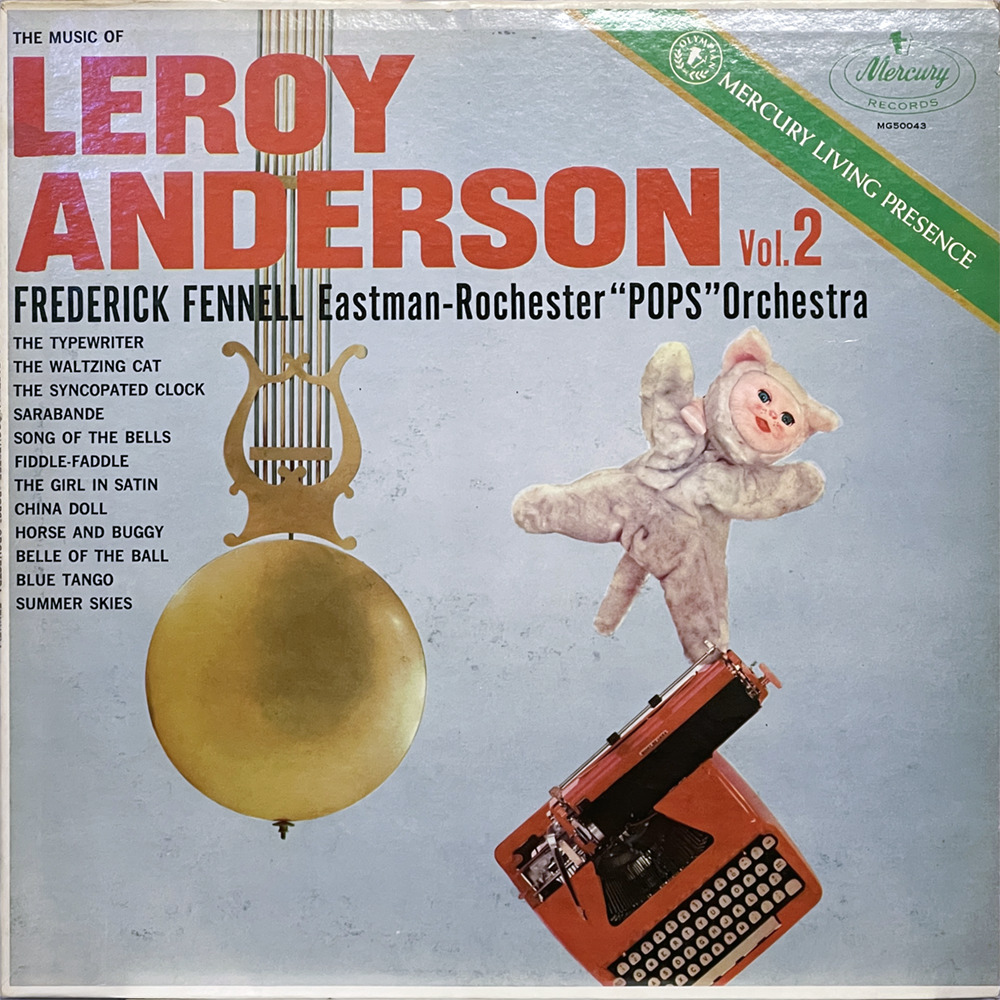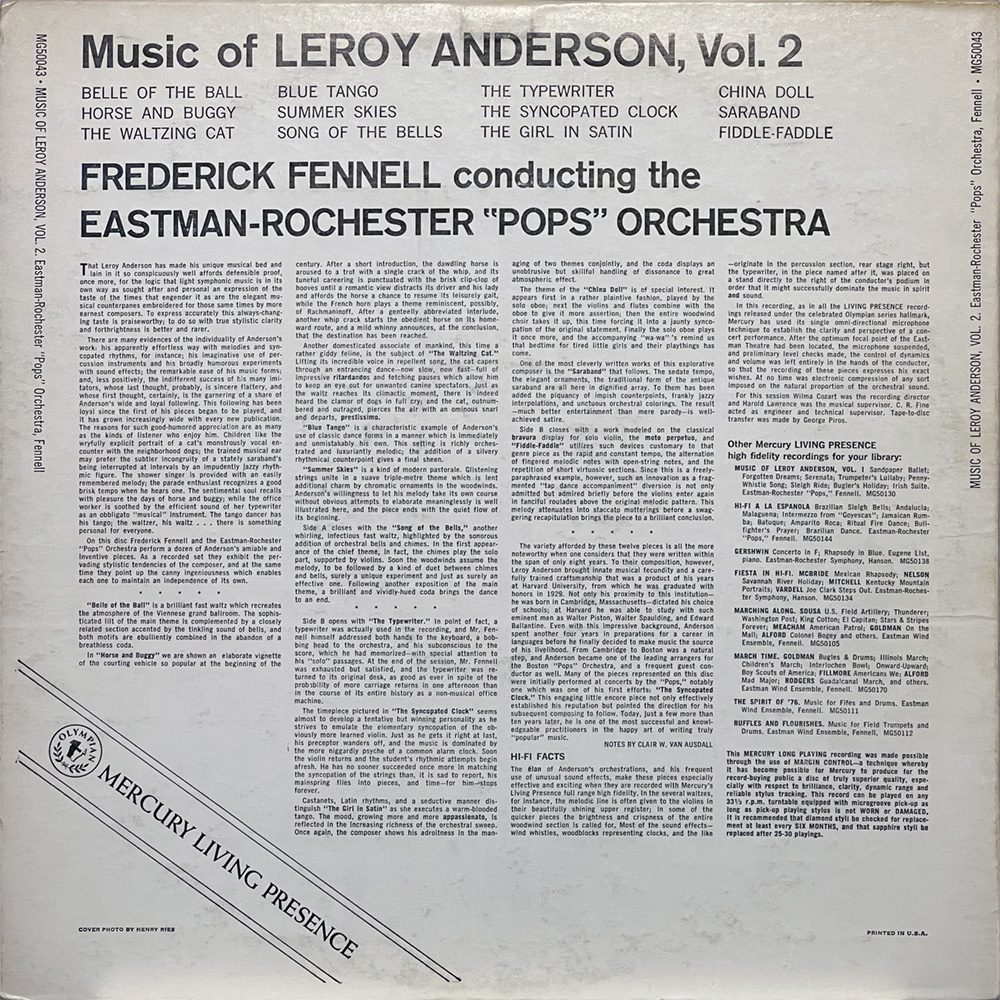Greetings, fellow audio enthusiasts! I’m Finnley the Dolphin, your guide through the ocean of forgotten sounds and undiscovered musical treasures. Today, we’re diving deep into the fascinating world of Mercury Records, a label that not only revolutionized the music industry but also brought us the magical Mercury Living Presence and Olympian Series. Our spotlight today shines on a gem from this collection: Frederick Fennell conducting the Eastman-Rochester Pops Orchestra in Music of Leroy Anderson, Vol. 2. So, grab your snorkels and flippers, and join me as we explore the innovative spirit, iconic recordings, and timeless legacy of Mercury Records. Let’s embark on this journey together and uncover the stories behind the music that continues to inspire and captivate listeners around the world.
The story of Mercury Records begins in the bustling city of Chicago in 1945. In the aftermath of World War II, America was experiencing a cultural renaissance, and the music industry was at the forefront of this transformation. Four visionaries—Irving Green, Berle Adams, Ray Greenberg, and Arthur Talmadge—saw an opportunity to create something extraordinary. Together, they founded Mercury Records, a label that would not only challenge the norms of the music industry but also redefine them.
Mercury Records quickly established itself as a significant force in American music. Its innovative marketing techniques and diverse catalog set it apart from its competitors. The label’s early years were marked by an eclectic mix of genres, including rock, funk, R&B, doo-wop, soul, blues, pop, rock and roll, and jazz. This diversity allowed Mercury to reach a wide audience and build a loyal following.
One of Mercury’s early breakthroughs was the promotion of records through jukeboxes, a strategy that set it apart from competitors relying on radio airplay. This cost-effective approach helped Mercury penetrate the pop market with artists like Frankie Laine, Vic Damone, and Patti Page. The label’s use of overdubbing in Patti Page’s hit “Confess” marked another significant milestone. At the time, the budget was too small to hire a second singer for the “answer” parts in the song, so Page recorded both parts herself. This pioneering use of tape overdubbing set a precedent for future recording techniques and showcased Mercury’s willingness to push the boundaries of what was possible in the studio.
Mercury’s jazz division, operating under the EmArcy label, also made a substantial impact. Featuring post-swing and bebop artists such as Clifford Brown, Max Roach, Dinah Washington, and Cannonball Adderley, the label became a hub for some of the most innovative jazz musicians of the era. Mercury’s dedication to jazz and classical music further cemented its reputation as a label committed to artistic excellence.
In 1951, Mercury Records embarked on a revolutionary journey with the launch of the Mercury Living Presence series. This groundbreaking series was spearheaded by recording engineer C. Robert (Bob) Fine and recording director David Hall. Fine, an inventor and consultant in sound recording for films and television, brought a wealth of technical expertise to the project. His innovative spirit and deep understanding of audio engineering played a crucial role in shaping the distinctive sound of Mercury Living Presence recordings.
The first record in this new series was Pictures at an Exhibition, performed by Rafael Kubelík and the Chicago Symphony Orchestra. Utilizing a single microphone to capture the performance, Fine and Hall created a recording that was both clear and dynamic, capturing the essence of the live performance. Critics and listeners alike were captivated by the sound quality, with Howard Taubman of The New York Times describing it as “being in the living presence of the orchestra.” This high praise set the stage for the series’ future success.
At the heart of Mercury Living Presence’s success were Wilma Cozart and Robert Fine. Wilma Cozart, born on March 29, 1927, in Aberdeen, Mississippi, began her career as the personal secretary to conductor Antal Doráti. Her talent and dedication quickly caught the attention of Mercury Records, and in 1954, she was promoted to vice president. Cozart’s exceptional skills as a producer and her meticulous attention to detail made her an invaluable asset to the label.
In 1957, Wilma married Robert Fine, and together, they formed a dynamic duo that would leave an indelible mark on the recording industry. Bob Fine, born on February 28, 1922, in New York, was an American recording engineer renowned for his work on the Mercury Living Presence series. He founded Fine Recording Studios in New York in 1958, where he continued to innovate and push the boundaries of audio engineering. Fine’s expertise in stereo recording techniques and his contributions to the development of long-play records earned him several awards and cemented his legacy as a pioneer in the field.
Building on the success of the Mercury Living Presence series, Mercury launched the Olympian Series, which featured some of the most iconic recordings in classical music history. Under the leadership of conductor Antal Doráti, the Minneapolis Symphony Orchestra recorded numerous acclaimed albums. These recordings were characterized by their clarity, depth, and dynamic range, setting a new standard for classical music recordings.
Among the most notable achievements of the Olympian Series were the first complete recordings of Tchaikovsky’s ballets Swan Lake, The Sleeping Beauty, and The Nutcracker. These recordings were praised for their meticulous attention to detail and their ability to capture the full spectrum of the orchestral performance. Doráti’s recordings of Tchaikovsky’s 1812 Overture became legendary, featuring dramatic overdubs of artillery and carillon bells. These recordings not only showcased the technical prowess of Mercury’s engineering team but also highlighted the label’s commitment to artistic excellence.
Another highlight of the Mercury Living Presence series was the collaboration with Frederick Fennell and the Eastman-Rochester Pops Orchestra. Frederick Fennell, a conductor renowned for his dynamic style and innovative interpretations, brought a fresh perspective to the recordings. Born on July 2, 1914, in Cleveland, Ohio, Fennell had a distinguished career as a conductor and educator. He founded the Eastman Wind Ensemble at the Eastman School of Music, which became a model for wind ensembles worldwide.

Fennell’s work with the Eastman-Rochester Pops Orchestra on the Music of Leroy Anderson, Vol. 2 album is a testament to his artistry and vision. Released in 1958 under the Mercury Living Presence label (MG50043), this album featured a collection of Leroy Anderson’s most beloved compositions, performed with precision and flair. Anderson, an American composer known for his light orchestral music, had a knack for creating pieces that were both whimsical and sophisticated.

The album opens with “Belle Of The Ball,” a lively and elegant piece that sets the tone for the rest of the album. This is followed by “Horse And Buggy” and “The Waltzing Cat,” both of which showcase Anderson’s playful style. “Blue Tango,” one of Anderson’s most famous compositions, is rendered beautifully by Fennell and the orchestra, capturing the piece’s rhythmic charm.
Side B of the album features some of Anderson’s most iconic works. “The Typewriter,” a piece that mimics the sounds of an old-fashioned typewriter, is a standout track. The orchestra’s precise timing and playful interpretation make it a delight to listen to. “The Syncopated Clock,” another fan favorite, is performed with the perfect balance of whimsy and rhythm, bringing Anderson’s musical clock to life. Other notable tracks include “China Doll,” “Saraband,” and “Fiddle-Faddle,” each performed with the same level of excellence that characterized the Mercury Living Presence series.
By the late 1950s, Mercury Records continued to innovate, this time in the realm of stereo recording. The label began using three omnidirectional microphones for stereo recordings on three-track tape, an expansion of their mono process. The center microphone remained paramount, capturing the core of the performance, while the side microphones provided depth and width. This technique allowed Mercury to create stereo recordings that were both immersive and lifelike.
In 1961, Mercury enhanced this technique by using 35-mm magnetic film instead of half-inch tape for recording. The greater emulsion thickness, track width, and speed of 35-mm magnetic film improved the frequency range and transient response, resulting in recordings of unparalleled clarity and fidelity. The Mercury Living Presence stereo records were mastered directly from the original three-track tapes or magnetic film. In the mastering room, a 3-2 mixdown process was used to combine the three tracks into a two-channel stereo format. This meticulous approach ensured that the final recordings were as close to the original performance as possible.
The Mercury Living Presence series continued to thrive, with Wilma Cozart Fine taking over as recording director in 1953. Her meticulous production and reissue work in the 1990s helped preserve the legacy of these recordings. Mercury’s catalog featured other prestigious orchestras, including the Eastman Rochester Orchestra under Howard Hanson, the Eastman Wind Ensemble under Frederick Fennell, and the Detroit Symphony Orchestra under Paul Paray. Each of these recordings was marked by the same attention to detail and commitment to excellence that had become the hallmark of the Mercury Living Presence series.
In the 2010s, Decca Classics, the current owner of the Mercury Living Presence label, issued several box sets, bringing these iconic recordings back to life. These reissues included remastered versions of the original titles, bonus CDs, and deluxe booklets detailing the history of Mercury Living Presence. The release of these sets introduced a new generation to the rich and vivid sound of Mercury’s classical recordings.
In 2012, Decca Classics issued a value-priced 51-CD box set that included 50 of the 1990s CD titles remastered by Wilma Cozart Fine, a bonus CD containing an interview with Cozart Fine, and a deluxe booklet. A limited-edition six-LP box set was also released. The success of this set led to a second 55-CD box set and another six-LP box set in 2013, further solidifying the legacy of Mercury Living Presence.
As we resurface from our deep dive into the history of Mercury Records, I hope you’ve enjoyed uncovering the fascinating stories and groundbreaking innovations behind the Mercury Living Presence and Olympian Series. The journey from a small Chicago-based label to a global music powerhouse is truly remarkable. The contributions of visionaries like Wilma Cozart and Robert Fine, along with the dynamic artistry of Frederick Fennell and the Eastman-Rochester Pops Orchestra, have left an indelible mark on the recording industry.
Our featured record, Music of Leroy Anderson, Vol. 2, is a shining example of Mercury’s dedication to excellence and innovation. The whimsical and sophisticated compositions of Leroy Anderson, brought to life by Fennell and his orchestra, continue to enchant listeners with their timeless charm.
Thank you for joining me, Finnley the Dolphin, on this audio adventure. Stay tuned for more journeys into the world of forgotten sounds and undiscovered musical treasures. Until next time, keep exploring and let the music guide you!
Sources:
“Frederick Fennell Conducting The Eastman-Rochester Pops Orchestra – Music Of Leroy Anderson, Vol. 2.” Discogs, retrieved 6 July 2024, https://www.discogs.com/release/2964764-Frederick-Fennell-Conducting-The-Eastman-Rochester-Pops-Orchestra-Music-Of-Leroy-Anderson-Vol-2.
“Mercury.” Discogs, retrieved 6 July 2024, https://www.discogs.com/label/39357-Mercury?page=1.
“Frederick Fennell.” Discogs, retrieved 6 July 2024, https://www.discogs.com/artist/1207102.
“Leroy Anderson.” Discogs, retrieved 6 July 2024, https://www.discogs.com/artist/1123182.
“Mercury Living Presence.” Soundfountain, retrieved 6 July 2024, http://www.soundfountain.com/amb/mercury.html.
Gaston-Bird, Leslie. Women in Audio. Taylor & Francis, 2019.
Schmidt Horning, Susan. Chasing Sound: Technology, Culture, and the Art of Studio Recording from Edison to the LP. Johns Hopkins University Press, 2013.
“Mercury Classical; A Leader in Music, A Leader in Sound.” Billboard, 27 May 1972, p. M-10. Anniversary Special Sponsored by Mercury Records.
Cipolla, Frank J., and Donald Hunsberger, editors. The Wind Ensemble and Its Repertoire: Essays on the Fortieth Anniversary of the Eastman Wind Ensemble. Alfred Music, 1999.
